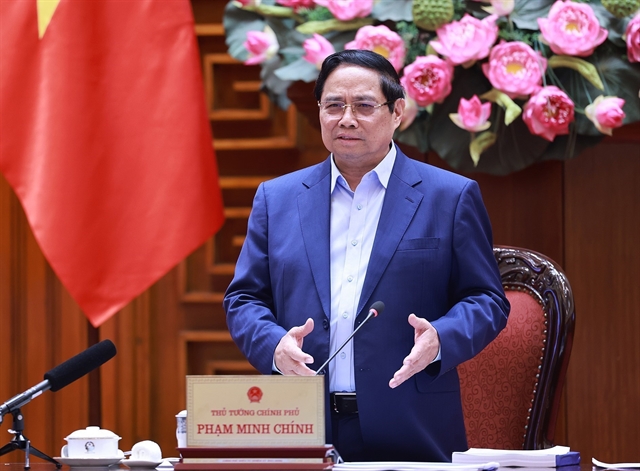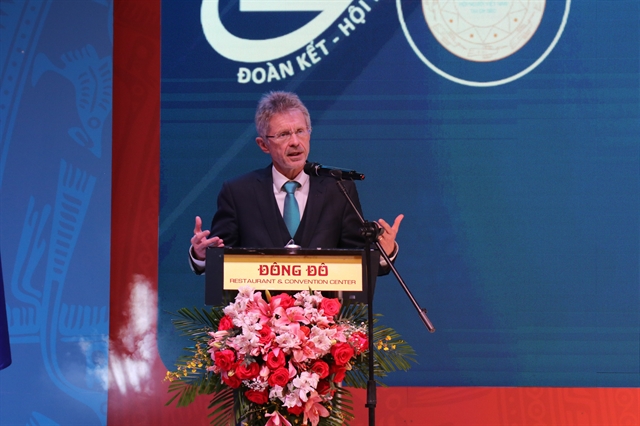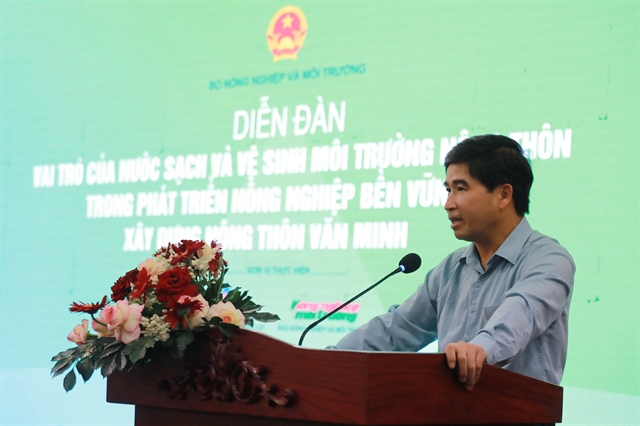 Society
Society


|
| Lương Văn Anh, deputy director of the Department of Hydraulic Works Management and Construction, speaks at the forum. — Photo Nguyễn Thủy |
HCM CITY — Clean water and environmental sanitation are essential pillars of sustainable and modern rural development in Việt Nam, as they not only support daily life and safeguard public health but also form the foundation for safe and sustainable agricultural production, speakers said at a forum held in HCM City on October 16.
Speaking at the forum, Vũ Minh Việt, deputy editor-in-chief of the Nông nghiệp và Môi trường (Agriculture and Environment) newspaper, said Việt Nam is moving toward a green, clean, and circular agricultural economy that adapts to climate change.
“In this context, ensuring clean water supply and improving rural sanitation are more urgent than ever, as most agricultural activities, particularly farming and livestock, are closely tied to water and the surrounding environment. A clean, pollution-free countryside provides the basis for building green, beautiful, and modern rural areas,” he said.
Giáp Mai Thùy, deputy head of the Rural Clean Water Management Division under the Department of Hydraulic Works Management and Construction, said that rural clean water supply has played a crucial role in implementing the National Target Programme on New Rural Development.
Currently, about 68 per cent of rural households nationwide have access to water that meets national quality standards, with 60 per cent using water from centralised supply systems and 8 per cent from household water systems.
However, Thùy noted that investment resources for rural clean water programmes remain limited. Between 2020 and 2024, total funding for the programme reached VNĐ13.4 trillion (US$509.1 million), while the estimated demand for 2021–2025 is VNĐ29.2 trillion ($1.1 billion), leaving a shortfall of nearly VNĐ16 trillion ($608.1 million).
Under the National Strategy on Rural Clean Water Supply and Sanitation to 2030, with a vision to 2045, Việt Nam aims for 80 per cent of rural households to use clean water from standardised systems by 2030. By then, 100 per cent of water supply units are expected to have sufficient capacity to completely resolve domestic water shortages in areas facing difficulties, pollution, or saltwater intrusion. By 2045, all rural residents are expected to have access to clean water.
To achieve these goals, speakers called for a comprehensive and coordinated approach. They emphasised the need to strengthen the legal and policy framework for rural water management and to invest in large-scale, modern water supply systems, prioritising areas prone to water scarcity, drought, or salinity intrusion, as well as remote, mountainous, and island regions.
At the same time, local authorities should review and adjust water pricing to reflect actual conditions, while encouraging household-level water collection and treatment solutions in areas where centralised systems are not yet viable.
Thùy also highlighted the importance of mobilising diverse funding sources, including state budgets, ODA, and international assistance, and promoting communication and education campaigns to encourage safe and economical water use, as well as community participation in maintaining and protecting rural water facilities.
Lương Văn Anh, deputy director of the Department of Hydraulic Works Management and Construction, stressed that digital transformation in rural water management is both inevitable and strategic.
“Applying digital technologies in managing, monitoring, and operating water systems improves efficiency, ensures equitable access, and protects water resources – laying the foundation for smart, livable rural communities,” he said.
Forum participants also discussed practical directions for modernising rural water infrastructure, integrating digital technologies, and developing policies to attract private and community investment in rural water services.
They further emphasised the importance of raising public awareness about sanitation, water conservation, and environmental protection, and linking clean water initiatives with high-tech, circular, and low-emission agricultural development.
The forum was co-organised by the Department of Hydraulic Works Management and Construction and the Agriculture and Environment newspaper. — VNS


.jpg)

